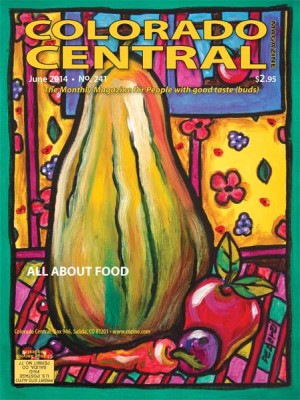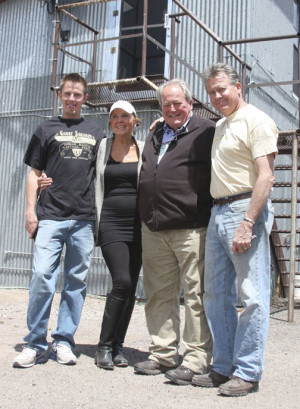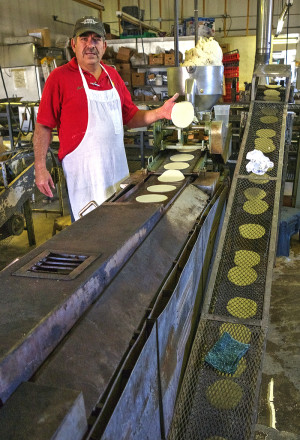By Ericka Kastner
My eyes flooded with tears as Penn placed the packet of Poma Amoris tomato seeds in the palm of my hand as a gift. In that moment, what I’d known for years was confirmed, – growing food from seed was an extension of my soul. And in Penn, I’d found a kindred spirit.
Penn and Cord Parmenter live at 8,120 feet on 43 acres of land in the Wet Mountains, near Westcliffe with their three boys, where they practice what they describe as “extreme homesteading.” Cord, a master blacksmith and designer of their now globally known smart greenhouses, works side by side with Penn, a clay artist-turned -green thumb, to grow food, collect seeds and teach high altitude gardening to others.
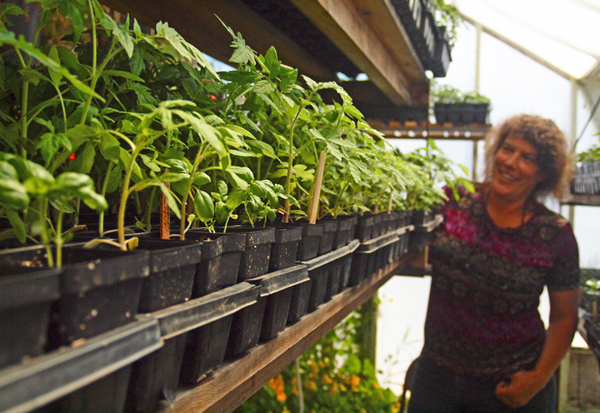
For 22 years, they’ve done what many said they couldn’t – they’ve grown tomatoes, corn, squash and other seemingly lowland crops at high altitude. Penn says she started growing tomatoes “because I was told I couldn’t grow tomatoes. Now I’m a lunatic with an addiction.” In their greenhouses, made entirely from salvaged materials heated and cooled by water, they grow year-round, yielding their best fruits in winter when the incidence of bugs and disease is at its lowest.
Poma Amoris Minora Lutea, or “Little Yellow Love Apple” hails from Padua, Italy, circa 1553 and is just one of the 130 varieties of heirloom tomato seeds Penn has collected. As a member of Seed Savers Exchange, Penn has traded for seeds from a Russian woman living in Italy and Iraqi gardeners risking their lives mailing seeds out of the country.
“Russians are the high altitude tomato kings,” Penn says. “They’ve saved their seeds for years because their mountains are more rugged, and in many areas they have no roads. They have to save seeds.”
Because there are thousands of tomatoes varieties, for hardcore “horties,” seed saving can become an obsession. Penn recalls pulling an all-nighter hunting down 84 different seeds from around the world that she found in a pictorial “tomato porn” book and had to have.
Tomato seeds that she collects and grows from areas like Siberia offer better yields than seeds coming from New Jersey because of the similarity in high altitude climate. When picking which seeds to save from her own plants each year, Penn saves for flavor, earliness and cold setting. Seeds store memory about their microclimate, and she says gardeners choosing to save their own seeds will see a difference in their plants even in the first planting year.
“If you are going for an early tomato, save seeds from the first tomato. If you are looking for flavor, save seeds from the most flavorful tomato from your crop.”
Seed savers imitate nature’s seed-saving process, usually occurring inside of a tomato on the ground, inside of a jar. Collected seeds and pulp are squeezed into the jar to ferment for three days. Once mold forms, breaking down the germination inhibiting gel inside the tomato, the seed is released from the pulp, purifying it from disease. The seeds are then ready to be rinsed, or decanted, in a jar of water. The viable seeds will sink to the bottom; once the seeds are rinsed and dried, they are ready for storage. Contrary to what gardeners are told by seed companies, Penn says seeds will keep for hundreds of years.
“They may be slower to germinate. You may have to be more patient, but after the plant grows, you have new, fresh seeds. When you hold a seed, you are holding millions of seeds.”
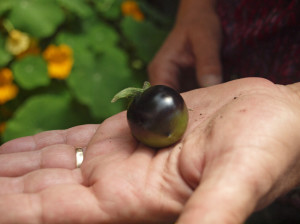 Penn began saving seed in 2009 when she and Cord attended seed school together. Not long afterwards, they set up a seed library at the Westcliffe public library. She does sell her plants to a local greenhouse, but her business primarily focuses on selling high altitude seeds. “The plants happen because I just can’t stop growing them.”
Penn began saving seed in 2009 when she and Cord attended seed school together. Not long afterwards, they set up a seed library at the Westcliffe public library. She does sell her plants to a local greenhouse, but her business primarily focuses on selling high altitude seeds. “The plants happen because I just can’t stop growing them.”
This spring she and Cord will break ground for a new 50-foot long greenhouse. The business of building and teaching others how to build smart greenhouses is expanding rapidly as well (they’ve had online requests from Canada, Australia and Austria), and the two recently reached out to the Small Business Development Center for guidance because they are struggling to keep up with the demand.
“In the beginning, many people told us with great concern that we couldn’t make a living up here. We’re too little to be this big, and we’re getting too big to be this little,” Penn says.
Penn and Cord encourage gardeners to work with the native elements of the land, rather than bringing in soil and fertilizer from external ecosystems. Their recipe for the perfect soil? Equal parts bottomland soil, arroyo sand and horse manure.
She says five hours in the Colorado sun is equal to 12 hours of sun elsewhere, and they grow an amazing amount of food in partial to full shade on the side of a mountain.
“They say you can’t grow anything in Colorado. Well, Colorado can.”
www.pennandcordsgarden.com, 719-783-2917


